- Home
- TV History
- Network Studios History
- Cameras
- Archives
- Viewseum
- About / Comments
Skip to content


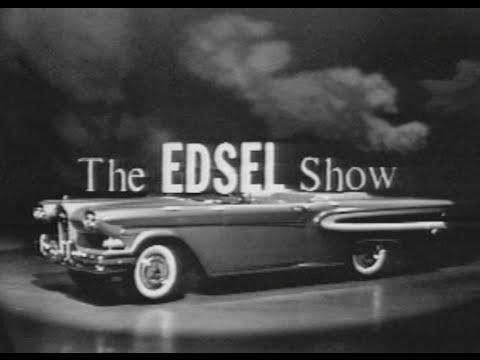

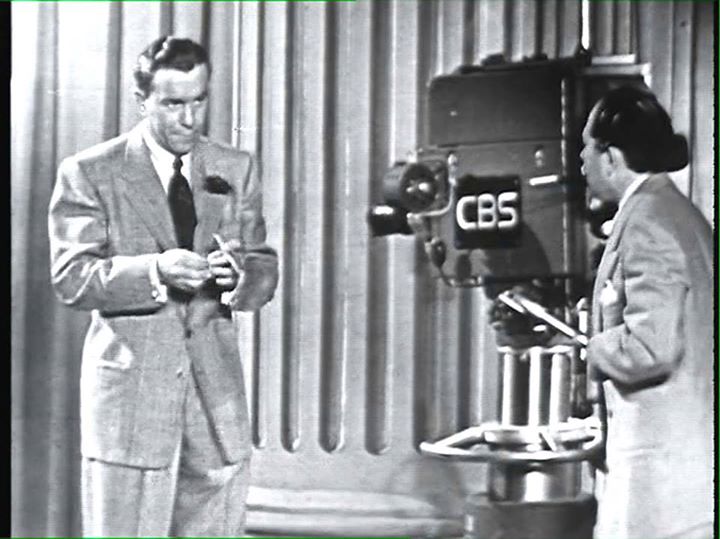













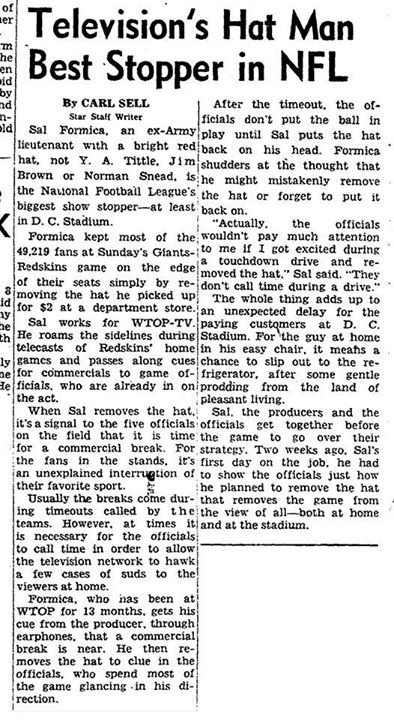

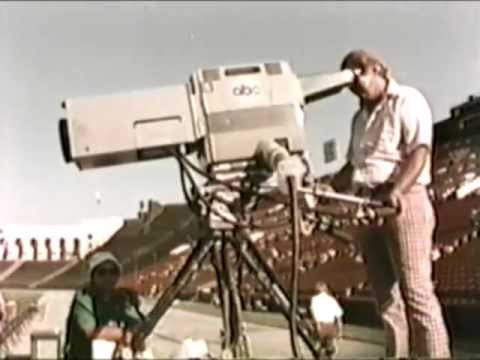

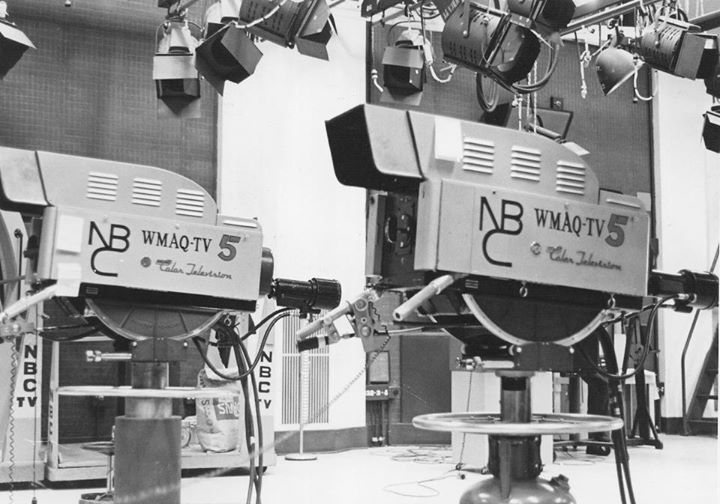

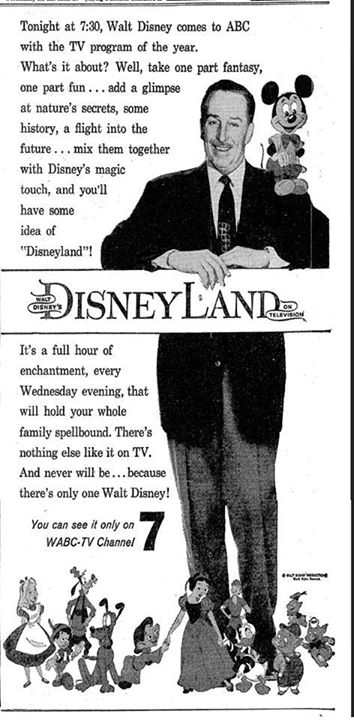



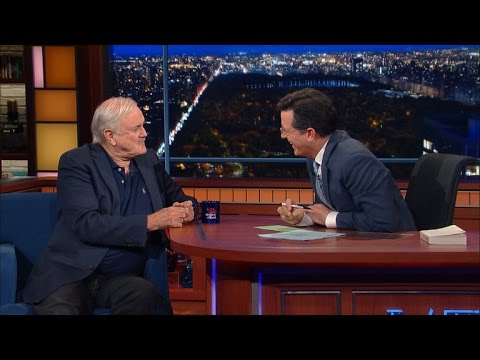

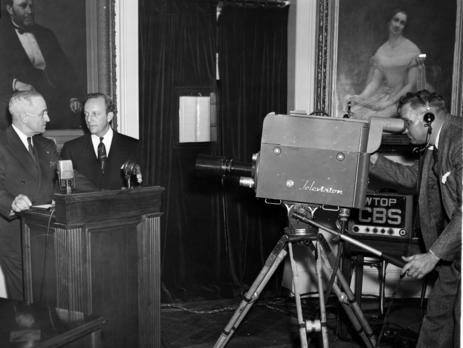



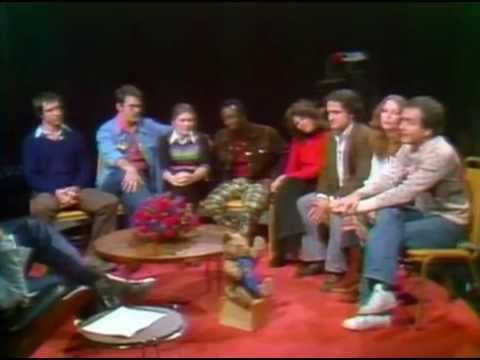



Posts in Category: TV History
Page 13 of 136
« Previous
1
2
3
4
5
6
7
8
9
10
11
12
13
14
15
16
17
18
19
20
21
22
23
24
25
26
27
28
29
30
31
32
33
34
35
36
37
38
39
40
41
42
43
44
45
46
47
48
49
50
51
52
53
54
55
56
57
58
59
60
61
62
63
64
65
66
67
68
69
70
71
72
73
74
75
76
77
78
79
80
81
82
83
84
85
86
87
88
89
90
91
92
93
94
95
96
97
98
99
100
101
102
103
104
105
106
107
108
109
110
111
112
113
114
115
116
117
118
119
120
121
122
123
124
125
126
127
128
129
130
131
132
133
134
135
136
Next » October 13, 1947…”Kukla, Fran & Ollie” Debuts On Chicago’s WBKB
On October 13, 2016
- TV History
October 13, 1947…”Kukla, Fran & Ollie” Debuts On Chicago’s WBKB
At the link is a timeline of the shows milestones, including their October 13, 1947 debut as “The Junior Jamboree” on WBKB in Chicago, the move to WNBQ and NBC, and their last show, 10 years later, which was also on WBKB. http://kukla.tv/history.html
In the five years that the show ran on NBC nationally, fan mail averaged 5,000 letters a day, and the show’s ratings rivaled Milton Burle’s and even Ed Sullivan’s at CBS.
The photo is of one of the early shows at WBKB. The dolly was a home-made rig, with the camera mounted on a barber’s chair. Thanks for the memories, Burr, Fran, Kukla and Ollie! -Bobby Ellerbee


October 13, 1957…A Red Letter Day For Videotape & TV History
On October 13, 2016
- TV History
October 13, 1957…A Red Letter Day For Videotape & TV History
The first 4.5 minutes of the attached video tells the story and includes comparison shots of the videotape and kinescope version of the oldest surviving, intact videotape program, “The Edsel Show”.
Thanks to our friend Kris Trexler’s love of cars, his interest in classic television and his professional abilities as a film and videotape editor, we are able to see this…the oldest surviving video tape. He is the one who tracked down this tape that everyone said did not exist.
“The Edsel Show” was chosen to be the very first CBS entertainment program to be broadcast live to the nation from Hollywood, then “tape-delayed” for re-broadcast in the Pacific Time Zone. The show was performed at CBS Television City in Hollywood from 4pm-5pm Pacific Time for live viewing from 7pm-8pm Eastern Time. The show was simultaneously recorded on videotape at Television City, then played back 3 hours later for West Coast viewers at 7pm Pacific Time.
After the live broadcast, The Ford Motor Company hosted a lavish party at a Hollywood restaurant, where the cast and CBS and Ford execs wined and dined and watched the videotape playback of the show to the West Coast. The evolution from kinescopes to videotape recording was underway!
Not wanting to risk a high profile failure of the new technology, CBS also created a kinescope backup of the show which the engineers at Television City played simultaneously with the videotape, so in case the tape failed, CBS engineers could quickly switch to the kinescope “protection copy” of the show. Videotape was a new technology and there was much to risk if it failed during such an important broadcast, but it didn’t.
Now, back to the fascinating detective work Kris did… http://www.kingoftheroad.net/edsel/edselshow3.html
You can read the details at the link above from Kris’s website, but in a nutshell…the tape was not in the CBS Video Archives. The kinescope was, but the tape copy was on a TVC engineer’s desk who had personally saved the tape. Remember, part of the miracle of videotape was that it could be reused…the engineer knew it would be if he didn’t rescue it and after the playback, he took care of if for the rest of us to see! Thanks to him and Kris Trexler, here is the “The Edsel Show” that was done October 13, 1957 from CBS Television City. Enjoy and share! -Bobby Ellerbee
https://www.youtube.com/watch?v=Ze0Az9tdkHg
This is the oldest videotape recording in existence. The Edsel Show stars Bing Crosby, Frank Sinatra, Louis Armstrong, and Rosemary Clooney. Produced at CBS …
October 12, 1950…Burns And Allen Debuts On CBS Television
On October 12, 2016
- TV History
October 12, 1950…Burns And Allen Debuts On CBS Television
Their radio show started in 1936 but by 1950, it was time to move to television. When ‘The George Burns and Gracie Allen Show’ began on CBS Television October 12, 1950, it was an immediate success. The show was originally staged live before a studio audience and during its first three months, it originated from the Mansfield Theater in New York, then relocated to CBS’ Columbia Square facilities in Los Angeles.
Ever the businessman, Burns realized it would be more efficient to do the series on film and that started that process in the fall of 1952. The half-hour episodes could then be syndicated. From that point on, the show was shot without a live audience present, however, each installment would be screened before an audience to provide live responses prior to the episodes being broadcast. With 291 episodes, the show had a long network run through 1958 and continued in syndicated reruns for years.
After the live/kinescope series ended, the shows were filmed at General Service Studios. The sets were designed to look like their real-life residence, often using an establishing shot of the actual house at 312 Maple Drive, Beverly Hills, CA 90210.
The format had George watching all the action (standing outside the proscenium arch in early live episodes; watching the show on TV in his study in the filmed episodes), and breaking the fourth wall by commenting to the viewers.
During the course of the eight-year run, the TV show had remarkable consistency in its cast and crew. The episodes were produced and directed by Ralph Levy (1950–53), Fred de Cordova, who would go on to produce NBC’s “The Tonight Show Starring Johnny Carson” (1953-56), and Rod Amateau (1956–58).
In addition to cast members Harry Von Zell (replacing original announcer Bill Goodwin in September 1951), Bea Benaderet (who made the transition from the radio show), and Larry Keating, the original writing staff consisted of Sid Dorfman, Harvey Helm, Paul Henning, and William Burns (George’s brother). -Bobby Ellerbee
October 12, 1943…NBC Sells Blue Network: The Start Of ABC
On October 12, 2016
- TV History
October 12, 1943…NBC Sells Blue Network: The Start Of ABC
On October 12, 1943, Edward John Noble, the owner of Life Savers candy and radio station WMCA in New York, bought NBC’s Blue Network for $8 million.
This was the start of ABC, but even with Noble’s millions, the first 10 years was a hard slog financially. The one thing ABC did that made the struggling network so appealing to a new buyer was something done on a whim, that cost them nothing.
Without asking Nobles, ABC’s chief engineer had applied to the FCC for Construction Permits for 5 television licenses, all on Channel 7, in New York, Chicago, San Francisco, Los Angeles and Detroit. Shortly after, the FCC froze license applications due to an overwhelming crush of requests. The next part, putting these stations on the air would cost big money, and that is where the financial squeeze got serious. That was 1948.
In much the same way NBC was forced to sell the Blue Network,
the movie theater operator United Paramount Theaters (UPT) was forced to become an independent entity, separating itself from the film studio Paramount Pictures in 1949.
For its part, ABC was on the verge of bankruptcy, with only five stations and nine full-time affiliates. Its revenues failed to compensate for its heavy investments in buying and building stations. In 1951, Noble held a 58% stake in ABC, giving him $5 million with which to prevent ABC from going bankrupt with a loan from the Prudential Insurance Company of America.
Leonard Goldenson, the president of UPT, approached Noble in 1951 and proposed that UPT purchase ABC. Noble received further offers, including one from Bill Paley of CBS, but that would have forced CBS to sell at least its New York and Los Angeles stations. Goldenson and Noble reached a tentative agreement in the late spring of 1951 that ABC would become a subsidiary of UPT, but would remain autonomous in its management.
On June 6, 1951, UPT’s board of directors validated their tentative agreement. However, the transaction had to be approved by the FCC. Insofar as the Paramount Pictures film studio was already a shareholder of the DuMont Television Network, the FCC conducted a series of hearings to ensure whether Paramount was truly separated from United Paramount Theaters, and whether it was violating antitrust laws.
In 1952, when the FCC ended its freeze on applications for new stations, among the issues to be addressed was the approval of the merger between UPT and ABC.
On February 9, 1953, the FCC authorized UPT’s purchase of ABC in exchange for $25 million in shares, and the company was renamed American Broadcasting-Paramount Theaters, Inc.
The new company was based in Paramount’s headquarters at 1501 Broadway in New York, and owned six AM radio stations and many FMs, as well as five TV stations and 644 cinemas in 300 cities throughout the United States.
In consideration of this merger, UPT sold its television station in Chicago, WBKB-TV, to CBS for $6 million. CBS changed the calls to WBBM-TV. They kept ABC’s existing Chicago station, WENR-TV but moved the WBKB call letters to channel 7, which would eventually become WLS-TV. Goldenson began to sell some of the old theaters to finance the new television network.
On May 1, 1953, ABC’s flagship stations – WJZ, WJZ-FM and WJZ-TV in New York – adopted the callsigns of WABC, WABC-FM and WABC-TV, and moved to 7 West 66th Street, one block from Central Park.
At the same time, Goldenson had been trying to convince his movie studio friends to provide content for the network. ABC’s merger with UPT led to the creation of relationships with Hollywood’s film production studios, breaking a long quarantine that had existed between film and television.
Goldenson’s efforts paid off, and on October 27, 1954, the network was able to launch a “New ABC” campaign with the productions of several studios, including Metro-Goldwyn-Mayer, Warner Bros., and 20th Century Fox.
However, the most iconic (and ironic) of ABC’s relationships with Hollywood producers was its agreement with Walt Disney. Walt and his brother Roy contacted Goldenson at the end of 1953 to ask ABC to finance part of the Disneyland project in exchange for Disney’s production of a television series.
Walt wanted ABC to invest $500,000 and a guarantee of $4.5 million in additional loans, a third of the budget intended for the park. Around 1954, ABC agreed to finance Disneyland in exchange for the broadcasting of a new Sunday television program, “Disneyland”, which debuted on the ABC network on October 27, 1954 as the first of many anthology TV programs that Disney would broadcast over the course of the next fifty years. We all know the rest of the story! Enjoy and share! -Bobby Ellerbee


WNBC Moves From Studio 3C To Historic 3K
On October 11, 2016
- TV History
WNBC Moves From 3C To Historic 3K
In late 1935, NBC radio studio 3H was converted to become television’s first permanent home. This was where RCA and NBC did all their early experimental broadcasts and was the first home of “The Howdy Doody Show” as well as “Kraft Theater”.
On September 12, 1955, NBC dedicated Studio 3K, which was made by combining 3H and radio studio 3F, into the network’s first in-house color studio, and “Howdy Doody” was the first show done from here. It was also the home of the Kraft Kitchen set, where Ed Herlihy spent so many hours.
Up until earlier this year, 3K had been an MSNBC studio. Those few 3K shows are now in the new 4th floor news studio. Over a period of 7 weeks, WNBC has built a new news set there that is a kind of 360 use set.
Overnight, the great time-lapse video of the studio under construction was taken down, but here is the link with more info on the studio. Let me know if the video plays for you. -Bobby Ellerbee
http://www.newscaststudio.com/2016/10/10/nbc-new-york-debuts-new-home-gains-space-30-rock/
NBC New York debuts new home, gains more space at 30 Rock
NBC’s flagship O&O, WNBC-TV, moved into a new home Sunday night, greatly expanding the station’s … Read More


October 11, 1975…”NBC Saturday Night” Debuts, LIVE In Studio 8H
On October 11, 2016
- TV History
October 11, 1975…”NBC Saturday Night” Debuts, LIVE In Studio 8H
It would be 8 more months until the show became “Saturday Night Live”, after Howard Cosell’s ABC variety show (which had the same name) folded and give up the name, and the term “not ready for prime time players”.
The video below is a double bonus! First, it is one of the funniest every SNL sketches, from last year’s anniversary show, and second, with your mouse, you can get a 360 degree look at the studio as the sketch unfolds.
Congratulations to all our friends in 8H (some who have been there since the start), on the 41st birthday of one of television history’s most unique adventures! -Bobby Ellerbee
https://www.youtube.com/watch?v=3WyMSrAgPKc
Alex Trebek (Will Ferrell) tries his best to keep contestants Sean Connery (Darrell Hammond), Justin Bieber (Kate McKinnon), Tony Bennett (Alec Baldwin), Bur…


October 10, 2007…The Beginning Of The End For NBC Burbank
On October 10, 2016
- TV History
October 10, 2007…The Beginning Of The End For NBC Burbank
Some nine years ago, NBC’s Brian Williams broke the news.
“Days Of Our Lives”, which airs on NBC is still there, but it’s their production company that rents space in the building and not NBC. Beautiful downtown Burbank will never be the same.
http://www.youtube.com/watch?v=wgKBAQrvVqs
NBCUniversal plans to sell much of its 34-acre site in Burbank, California — the longtime home of “The Tonight Show,” and move operations to Universal Studi…
October 1950…FCC Approves CBS Color System, RCA Goes To Court
On October 9, 2016
- TV History
October 1950…FCC Approves CBS Color System, RCA Goes To Court
At the link below is the October 14, 1950 Billboard Magazine, which is a fantastic walk down memory lane, but notice the two stories at that bottom of page 3. This is where the color feud between CBS and NBC/RCA started. It was one of many feuds between the two.
This is one of 4 retro-fitted RCA TK30 black and white cameras CBS used in their Field Sequential color process. Notice the spinning color wheel behind the lens turret. -Bobby Ellerbee


October 9, 1986…’The Late Show With Joan Rivers’ Debuts On Fox
On October 9, 2016
- TV History
October 9, 1986…’The Late Show With Joan Rivers’ Debuts On Fox
Here is the rare video of that first show with David Lee Roth, Pee Wee Herman, Elton John and Cher. In the story, some surprises I had never known about till now. Read on!
We all know that the Fox announcement of the show caught Johnny Carson by surprise and caused him never to speak with Joan again, BUT…as you will see, Rivers had some pretty good reasons for playing her cards close to her chest.
Rivers had been Carson’s permanent guest host since 1983, and as 1986 neared, some executives at NBC thought it was possible that Johnny Carson would retire after reaching his 25th anniversary on October 1, 1987, as it was such a logical cut-off point. In the spring of 1986, a confidential memo went out to top NBC executives listing about 10 possible replacements in the event of Carson’s retirement. Rivers was shocked to see that she was not on the list.
In an article she wrote for People Magazine, Rivers said that NBC offered her only a one year contract in 1985 as permanent guest host while Carson’s contract had been renewed for two years, which signaled to her that her future was uncertain as her previous one year contracts had run the same length as Carson’s. In addition, Rivers noted numerous snubs from NBC executives over the years, such as not being invited to the annual Carson party until recently, and taking the fall for a controversial joke that management approved during rehearsal.
Rivers had received higher-paying offers from other networks in prior years but declined them out of her loyalty to Carson, but in 1986 as NBC was unwilling to give assurances on her future and negotiations were fruitless, this was the impetus for Rivers to seriously consider the Fox offer.
Fox was looking for a host for a late-night talk show for the network’s launch in October 1986 and offered Rivers the job at a salary higher than what NBC was paying. She accepted, and Carson was blindsided by the news when he saw the press conference on television.
Carson was furious and said that he felt betrayed by Rivers – not because she dared to compete with him, but because she was not honest with him beforehand about her intentions and did not ask him for advice and his blessing.
For her part, Rivers was adamant that her problem was with NBC and not with Carson, who was like a father figure to her. She stated that she didn’t want to tell Carson before the announcement was made because she was afraid Fox would cancel the deal if word leaked out. She had previously been ordered by Carson’s producers and lawyers not to go to him with her problems, as they kept Carson completely insulated since he was a major source of NBC profits. Carson had been completely unaware of Rivers’ problems with NBC.
-Bobby Ellerbee
https://www.youtube.com/watch?v=MckrtLdSIxs Part 1
https://www.youtube.com/watch?v=HHFHuARH0g0 Part 2
Here is the part 1 of the premiere of “The Late Show with Joan Rivers”, as broadcast on October 9, 1986. Joining Joan are guests David Lee Roth, Pee Wee Herm…
How Football Officials Knew When To Call A “TV TIME OUT”
On October 8, 2016
- TV History
How Football Officials Know When To Call A “TV TIME OUT”
How NFL TV Timeouts Were Handled Early On…
Back in the 50s and 60s, televised pro football had what were called “hat men” on the sidelines. They were connected by headphone to the director and here, from the Washington Evening Star, is an October 8, 1963 article on what their job was. Thanks to Maureen Carney for the image. Enjoy and share! -Bobby Ellerbee


Covering College Football…ABC Sports, October 4, 1975
On October 8, 2016
- TV History, Viewseum
Covering College Football…ABC Sports, October 4, 1975
This is the best ever look at how 60 men brought 30 million viewers these great games every Saturday. “Second’s To Play” is presented in it’s original 30 minute format.
This is the most extensive look you’ll ever get of how ABC Sports crews covered the games in this era. Norelco PC 70s are in use, and our friend Don “Peaches” Langford is on the sidelines with the 49 pound Norelco PCP 90 hand held. Enjoy and SHARE! -Bobby Ellerbee
October 8, 1948…NBC’s WNBQ TV In Chicago Signs On
On October 8, 2016
- TV History
October 8, 1948…NBC’s WNBQ TV In Chicago Signs On
Thanks to long time WMAQ staff member Edward Dabrowsky, and a few others, here are some great shots from times gone by.
The station signed on October 8, 1948, as WNBQ, the last of Chicago’s four commercial VHF stations to launch. WNBQ is also the third of the five original NBC owned-and-operated stations to begin operations, after New York City and Washington and before Cleveland and Los Angeles. Eight years later, it became the first station in the world to broadcast all of its programs in color.
Though NBC had long owned WMAQ radio, it did not change the TV station’s call letters to WMAQ-TV until August 31, 1964.
WMAQ-TV originated several programs for the NBC television network from its studios in the Merchandise Mart during the 1950s, including Kukla, Fran, and Ollie, featuring Burr Tillstrom and Fran Allison; Garroway at Large, starring Dave Garroway; and “Studs’ Place,” hosted by Studs Terkel. Television critics referred to the broadcasts – often low-budget with few celebrity guests but a good deal of inventiveness – as examples of the “Chicago School of Television.”
WMAQ-TV gained fame for its newscasts during the 1960s, anchored by Floyd Kalber, John Palmer, Jim Ruddle, and Jorie Luelof. Though its role as a program provider to NBC diminished in the 1960s, WMAQ-TV gathered and distributed more than 200 feeds per month of news footage from overseas and the central United States to NBC News.
Memory Lane…Debut Ads For Some Of TV’s Most Memorable Shows
On October 7, 2016
- TV History
Memory Lane…Debut Ads For Some Of TV’s Most Memorable Shows
Thanks to Maureen Carney, here are some classic newspaper ads for the debuts of some shows that went on to make history. Enjoy! -Bobby Ellerbee
October 7, 1960…Second Kennedy-Nixon Debate, NBC Washington
On October 7, 2016
- TV History
October 7, 1960…Second Kennedy-Nixon Debate, NBC Washington
These are newly found photos of the second debate between Senator Kennedy and Vice President Nixon at NBC’s WRC-TV.
As you will see in the video, linked below, the moderator was NBC’s Frank McGee, and panel of questioners included Edward Morgan from ABC, Paul Niven from CBS, Alvin Spivak from UPI, and Hal Levy from Newsday. All four debates were simulcast live on all three networks’ radio and television stations.
The first debate was at WBBM in Chicago and hosted by CBS on September 26. The third was hosted by ABC with Kennedy at WABC in New York and Nixon at KABC in Los Angeles on October 13. On October 21, the fourth and final debate was hosted by ABC in New York. -Bobby Ellerbee


October 5, 1969…”Monty Python’s Flying Circus” Debuts On BBC
On October 5, 2016
- TV History
October 5, 1969…”Monty Python’s Flying Circus” Debuts On BBC
How did one of the most beloved comedy shows of all time come to be? After hearing how the pitch went, it’s hard to believe that the show ever came to be…but it did! At 4 minutes into this fun trip down memory lane, John Cleese tells the story. SPAM! -Bobby Ellerbee
https://www.youtube.com/watch?v=W6xXcoVCKp0
Living legend John Cleese stops by to talk about his book “So, Anyway,” how he and his fellow Pythons pitched their show, and why fish are funny.
October 5, 1947…First Live Television Speech From The White House
On October 5, 2016
- TV History
October 5, 1947…First Live Television Speech From The White House
On this day in 1947, President Harry Truman became the first president to broadcast a speech live from the White House. The subject was food conservation, and Truman asked Americans to cut back on their use of grain in order to help starving Europeans. At the time, Europe was still recovering from World War II and suffering major shortages.
Although the majority of Americans did not see this live, because not many had a TV set, his speech signaled the start of a powerful and complex relationship between the White House and a medium that would have an enormous impact on the American presidency, from how candidates campaigned for the office to how presidents communicated with their constituents. Each of Truman’s subsequent White House speeches, including his 1949 inauguration address, was televised. In 1948, Truman was the first presidential candidate to broadcast a paid political ad.
Below, NBC’s WRC is shown providing TV pool coverage of the speech with CBS’s WTOP handling the radio pool. In those early pool days, coverage alternated between CBS and NBC, and both used unmarked cameras and microphones for these occasions. -Bobby Ellerbee


October 4, 1976…Barbara Walters Co Anchors ABC Evening News
On October 4, 2016
- TV History
October 4, 1976…Barbara Walters Co Anchors ABC Evening News
40 years ago today, Walters became the first female anchor for a US network evening news program. On her move from NBC’s “Today” show, she was teamed with ABC anchorman Harry Reasoner and the sparks immediately started to fly!
This short clip goes directly to the heart of the conflict and includes footage from that first night. Morbid curiosity was the main reason most viewers tuned in, and after the first week, the ratings bump went away as the dysfunction on screen continued. -Bobby Ellerbee


October 4, 1975…The Missed Debut Date For “Saturday Night”
On October 4, 2016
- TV History
October 4, 1975…The Missed Debut Date For “Saturday Night”
As it turns out, “The Not Ready For Prime Time Players” were not even ready for late night television! Really! Here’s the story…
NBC’s new 90 minute, live comedy show “NBC Saturday Night” was scheduled to debut at 11:30 on October 4, 1975. The plane truth is, they just could not get the show ready in time for a number of reasons, with timing and blocking among the biggest hurdles to overcome.
Although Tom Snyder’s “Tomorrow” show was a one hour, Monday – Friday production, NBC called on him at the last minute to do special 90 minute Saturday show to cover the SNL hole in their schedule.
Fortunately, Jerry Lewis was in town and agreed to do the show. For the first 85 minutes, he was the single guest. The last five minutes were reserved for the introduction of the SNL cast and it’s producer Lorne Michaels.
In this clip, you will see the first ever network appearance of the original cast of “NBC Saturday Night”. The debut show was one week later, on October 11, with George Carlin as host. Enjoy and SHARE! -Bobby Ellerbee


October 4, 1956….”Playhouse 90″ Debuts On CBS
On October 4, 2016
- TV History
October 4, 1956….”Playhouse 90″ Debuts On CBS
This is how television’s most distinguished anthology series started. Although the weekly 90 minute series only ran for four years, it is still held as the gold standard for live television drama.
Jack Palance is the host of this debut show, but the next week, he would star in “Requiem For A Heavyweight” which won Emmys for Best Director (Ralph Nelson) and Best Teleplay (Rod Serling) as well as a Peabody Award.
This debut broadcast was done from Studio 31 at CBS Television City and was directed by the renown John Frankenheimer. The script written by Rod Serling was an adaptation of the book by Pat Frank. To relieve the pressure of producing four 90 minute live shows a month, every third week a filmed episode was aired.
I have included a page of this first script that was used by John Frankenheimer. Enjoy and share! -Bobby Ellerbee
Kid Made Cameras…Thought You Were The Only One?
On October 3, 2016
- TV History
A while back, my friend John Bolin came from California to see my camera collection. He brought along a few old Kodak shots of a camera he made as a boy of 13. No doubt it’s a TK30 mock up, complete with toilet paper rolls for lenses and Christmas tree lights for tally lights. You really have to marvel at the friction head and the viewfinder hood! Most excellent work, John! Unfortunately, we can’t see the pedestal, but it had a steering ring and wheels, just like the big boys’ version.
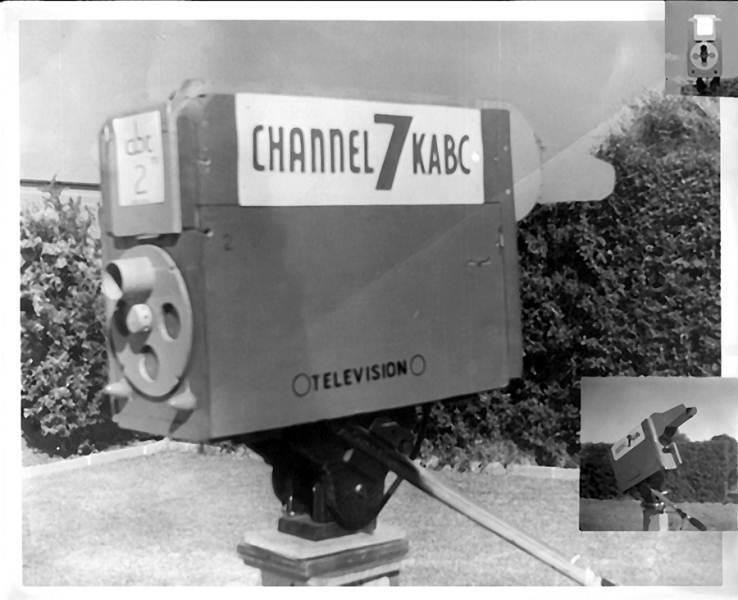
I made myself a camera at around age 10, and my dad even had one made for me for Christmas of 1961, when I would have been 11. It tilted up and down via a hinge in the pole that supported it, and unfortunately all it took was one good tilt forward and that was all she wrote, but it was the thought that counts. In conversations with many of you, I hear stories about the cameras many of you made, but like me, many of you drew them, too!
Below are more than a dozen really good pictures our friend Martin Perry drew as a kid. I swear, they look almost exactly like the pictures I used to draw. I started drawing them about age 10 and drew them until I was 15. Martin now runs Phillips Productions in Dallas, and owns a nice GE camera collection.


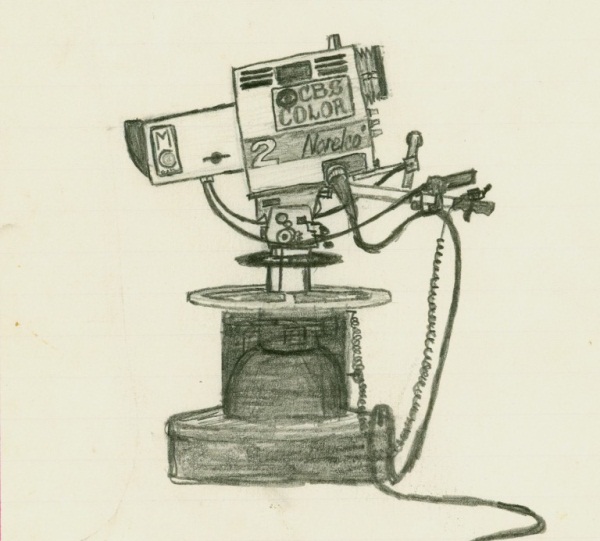
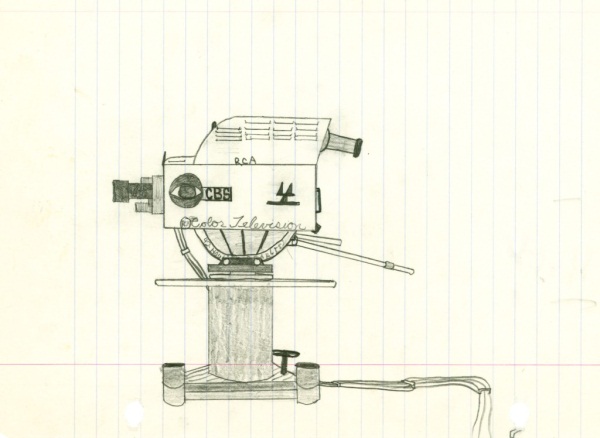
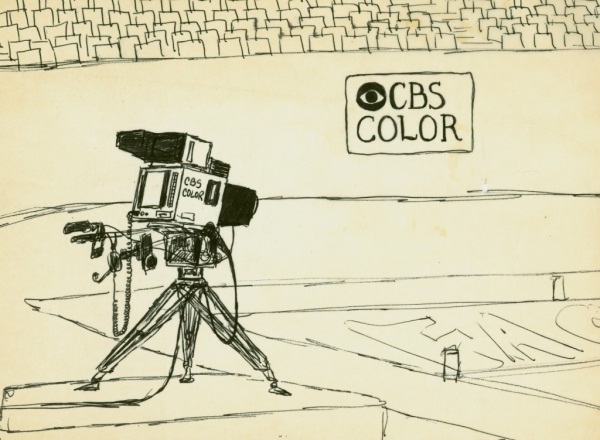


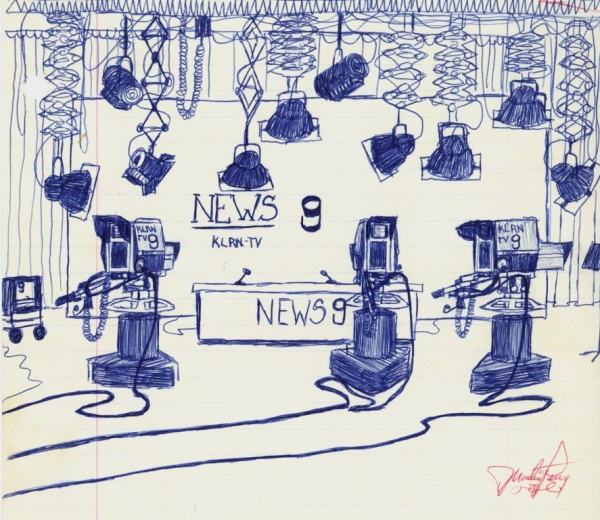


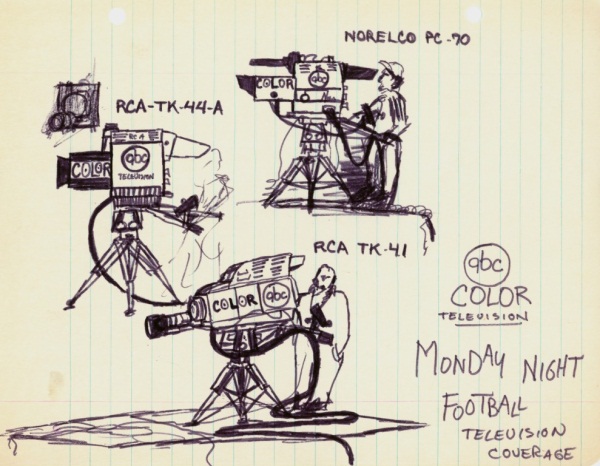
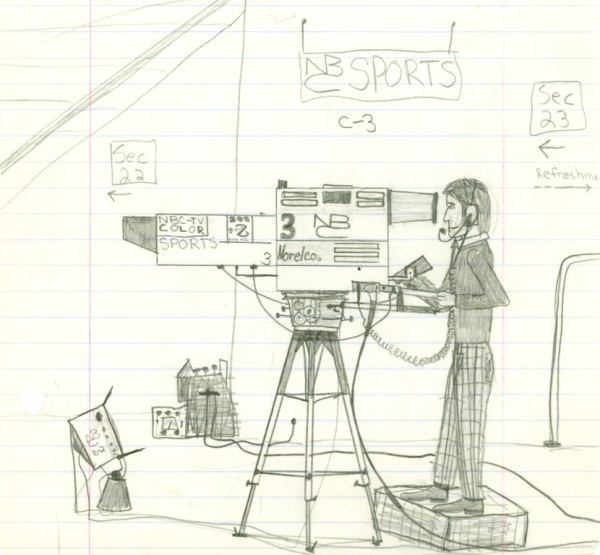


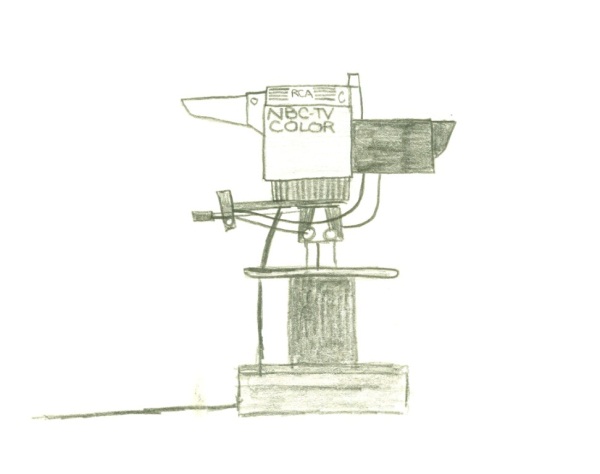

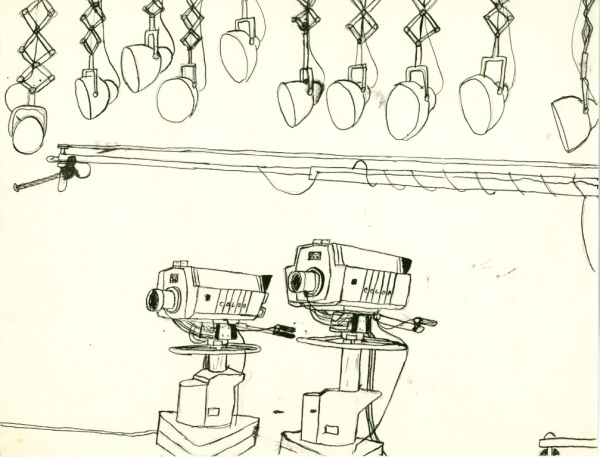
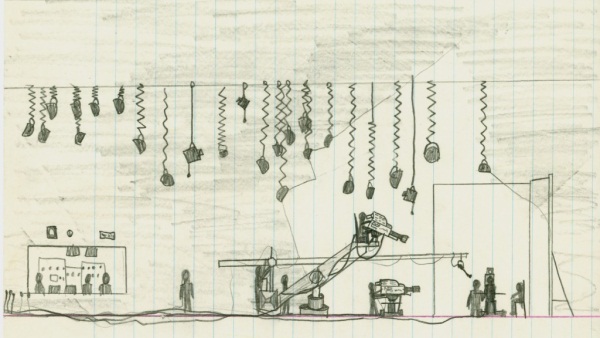
Page 13 of 136
« Previous
1
2
3
4
5
6
7
8
9
10
11
12
13
14
15
16
17
18
19
20
21
22
23
24
25
26
27
28
29
30
31
32
33
34
35
36
37
38
39
40
41
42
43
44
45
46
47
48
49
50
51
52
53
54
55
56
57
58
59
60
61
62
63
64
65
66
67
68
69
70
71
72
73
74
75
76
77
78
79
80
81
82
83
84
85
86
87
88
89
90
91
92
93
94
95
96
97
98
99
100
101
102
103
104
105
106
107
108
109
110
111
112
113
114
115
116
117
118
119
120
121
122
123
124
125
126
127
128
129
130
131
132
133
134
135
136
Next » 